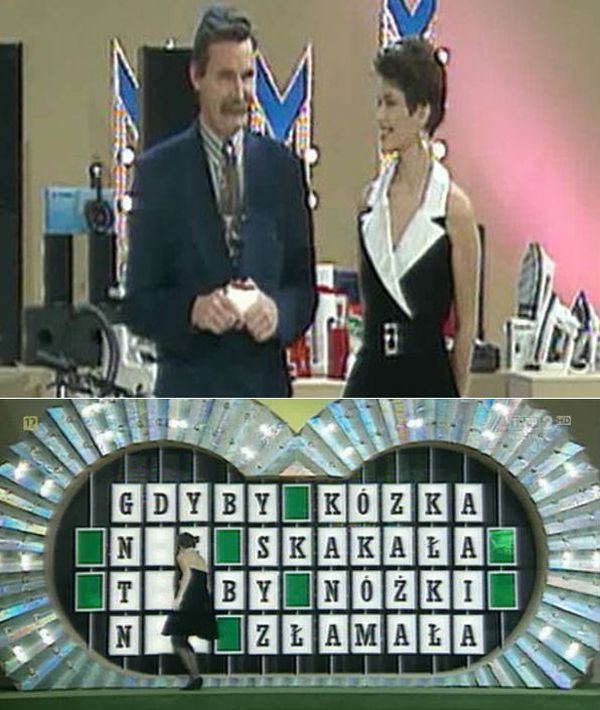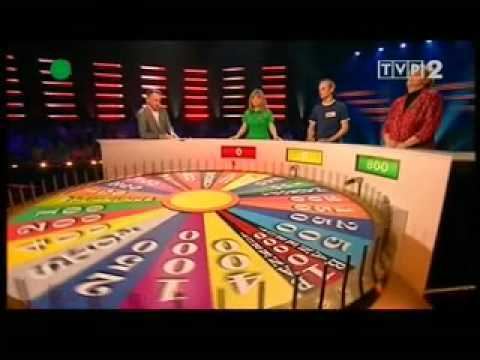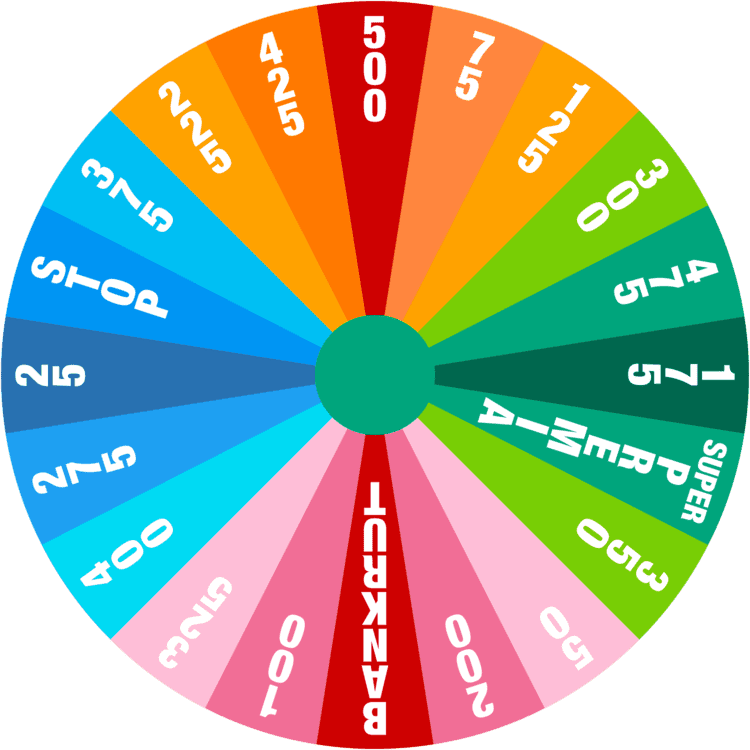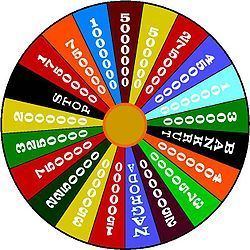Original language(s) Polish First episode date 2 October 1992 Number of episodes 1,000 Genre Game show | No. of episodes 1,000+ Final episode date 27 October 2009 Program creator Merv Griffin | |
 | ||
Production company(s) Uni Vision (1992-1998)TVP (2007-2009) Distributor Uni Vision (1992-1998)TVP (2007-2009) Presented by Wojciech Pijanowski, Paweł Wawrzecki, Stanisław Mikulski, Krzysztof Tyniec, Magdalena Masny Similar Game show, Milionerzy, Miliard w rozumie, Fifteen to One, Wheel of Fortune | ||
Wojciech pijanowski wspomina ko o fortuny wczoraj w tv 1
Koło Fortuny was the Polish version of Wheel of Fortune. The show first ran from 2 October 1992 to 1 September 1998 and ran in a revival on TVP2 from 29 October 2007 to 2009, when it was put off the air.
Contents
- Wojciech pijanowski wspomina ko o fortuny wczoraj w tv 1
- Draft ko o fortuny zaczynamy od legendy fifa 17
- Differences
- Toss Up
- Vowels
- Prizes
- Penalty Spaces
- The Bankrupt10000Bankrupt Wedge
- Mystery Wedges
- Bonus Round
- The Wheel
- References

For rules of the game, see the article entitled Wheel of Fortune (U.S. game show), as this article only describes the unique differences in the Polish version of the show. The 2007-09 run of the show was one of few versions to use a green podium instead of the traditional blue, using a red-yellow-green sequence. The original show used the reverse order of the American version's color sequence, with blue on the left, yellow in the middle, and red on the right.

Draft ko o fortuny zaczynamy od legendy fifa 17
Differences
There was only one Toss-Up puzzle and three rounds before the Bonus Round in the 2007 version.
Toss-Up

The toss-up was worth a dishwasher or a trip to a hotel in Poland. Whoever buzzed in and solved the puzzle first won the dishwasher or trip and began Round 1. If the first player was wrong, the next player in line got a shot at the puzzle. The puzzle board's border lighted up red, yellow, or green to show who had buzzed in.
Vowels
Vowels are worth zł200, and needed to be purchased prior to spinning the wheel.
Prizes

In Rounds 1 and 3, a purple wedge that had the letters AGD was placed on the wheel. In all three Rounds, two green or silver wedges that had Wycieczka were also placed on the wheel. Round 2 featured prizes that changed from show to show, labeled with the word Nagroda.

A player who landed on a wedge, called a correct letter, and immediately solved the puzzle (à la the Jackpot Round in the United States) won the prize; otherwise, they needed to spin the wheel again or buy a vowel.

AGD represented home appliances worth zł5000, and Wycieczka represented a bonus trip to places such as Italy, Canary Islands, etc. Nagroda represents any other prize, ranging from multimedia to scooters. Other prize spaces include Sklep Internetowy, which represented specific prizes related to the internet and computers, and Skuter, which specifically represented scooters.
Penalty Spaces
Bankrut (Bankrupt): This cost the player his or her turn plus all the money he or she earned in the round. Previous earnings were not affected.
Stop (Lose a Turn): Appropriately, the player's turn "stopped" and play passed to the next player. Scores were not affected under any circumstances.
The Bankrupt/$10,000/Bankrupt Wedge
In Round 2, a wedge that says Bankrut/10,000/Bankrut was placed on the wheel. Unlike the US version of Wheel of Fortune, and like the Filipino version and other European versions, landing on the zł10,000 section earns spendable cash as normal. Since it is worth zł10,000, a Bankrupt is placed on each side, making it harder to hit. It is unknown whether the money was awarded in multiples or was given at a flat rate but more than likely the latter occurred.
Mystery Wedges
In Round 3, two mystery wedges were placed on the wheel. One was hiding a Bankrupt, and the other was hiding zł10,000. When a player landed on a wedge, (s)he had a choice of choosing a letter for zł500 or flipping over the wedge. If it was a Bankrupt, regular rules to Bankrupt applied. If it was the zł10,000, the player had to choose a correct letter in order to receive the cash prize. If (s)he did, (s)he received zł10,000 regardless of how many times the letter appeared in the puzzle, but the money could still be used to purchase vowels. Both mystery wedges, including the unflipped one, were removed from the wheel.
Bonus Round
From 1992 to 1996, players who made it to the bonus round played for a car. From 1997 to 1998, they played for a collection of prizes usually valued at zł10,000. Although the Polish version did have a bonus round podium with envelopes like the American version did from 1989–2001, instead of prizes, all four envelopes contained three consonants and a vowel. All occurrences of the letters would be revealed and then the contestant would choose another three consonants and a vowel and then has 15 seconds to solve the puzzle (10 seconds from 1997–1998). Unlike the American version, the contestant was allowed only one guess of the puzzle. If time ran out or the contestant gave an incorrect answer, he/she did not win the bonus prize.
The 2007-2009 Polish bonus round was played just like the American version has been doing since 2001. The contestant spun a miniature bonus wheel filled with cars, trips, and cash prizes ranging up to zł50,000. The player received R, S, T, L, N, and E, selected three more consonants and a vowel, then had 10 seconds to solve the puzzle. This time, like the American version, the contestant was allowed an unlimited amount of guesses.
The Wheel
The layouts from late 1992 into early 1993, with the currency used during Poland's period of hyperinflation. "Lose A Turn" was known as "Strata Kolejki" at this time. The Nagroda (Prize) wedge was added in Round 2.
The layouts from 1993 to about 1995, with a changed color scheme. "Lose a Turn" became "STOP."
The layouts used in 1995, when Poland introduced their new złoty.
The layouts used from 1996 to about 1998, when Poland's 21 wedges were reduced to 20. Note the color pattern.
The layouts based on a March 2009 episode.
